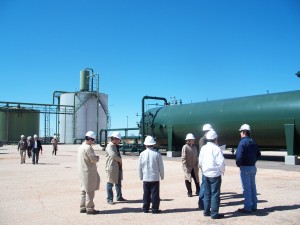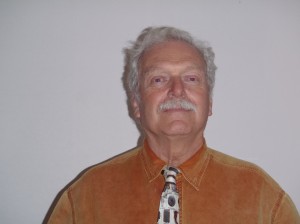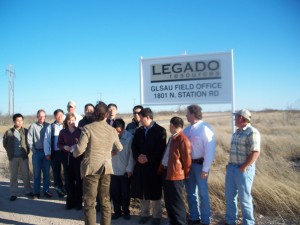 No matter where Larry Richards has traveled in the world, He always runs into someone who has been to the Permian Basin. As president of Midland-based Hy-Bon Engineering, Inc., he was in Siberia last year overseeing one of his company’s projects. “I told the group I was from Midland and two men held up their hands and said they had been to the Permian Basin,” Richards said.
No matter where Larry Richards has traveled in the world, He always runs into someone who has been to the Permian Basin. As president of Midland-based Hy-Bon Engineering, Inc., he was in Siberia last year overseeing one of his company’s projects. “I told the group I was from Midland and two men held up their hands and said they had been to the Permian Basin,” Richards said.
He faced a similar situation while in Libya. The head of engineering for the Libyan company Richards was working with attended the University of Texas in Austin 20 years ago. Other engineers on the project team had spent time in the Basin.
Midland, Odessa and the Permian Basin. They may not be exotic locales featured in travel catalogs, but this area is becoming the “Destination Education” center for petroleum industry personnel throughout the United States and the world. On any given week, hotels and motels in Midland and Odessa are filled with employees sent by their companies to learn the latest technology dreamed up, researched, implemented and refined in one of the world’s most advanced oilfields. They come for the internationally renown CO2 School or various other seminars offered by area educational entities.
When most of the major oil companies had offices in Midland, the Permian Basin was the first stop for new hires. As a young employee with ARCO Oil & Gas, W. Hoxie Smith was sent to Midland to learn the basics. “All the majors would send their new hires here,” he recalled. “This is the lab for the oil and gas industry.”
More than 40 years ago, geologist Jack Elam observed a need for a place to provide continuing education for industry employees who needed to maintain their certification. He founded the Graduate Center in downtown Midland and it became a center for anyone in the industry needing continuing education, according to Smith who now serves as its director.
In July 2004, the Center merged with Midland College and the name was changed to Petroleum Professional Development Center (PPDC), he said.
“There were so many geoscientists here that Jack wanted to give them an opportunity for continuing education so they could keep up with changes in the industry,” Smith said. “This center was designed for the regional Permian Basin oil and gas industry.” Today, it offers classes almost every week that attract not only people from out of state but also the international arena. Students have placed pins on a world map in the building’s hallway to show their native country.
“Those pins represent students from Vietnam, Australia, New Zealand, China, Peru, Ecuador, Argentina, Venezuela, Africa, Russia, Great Britain and Canada. Basically, it’s every continent except the Antarctica,” Smith said.
A dozen years ago, Jim Henry envisioned a similar project, this one aimed at educating people from other countries. As the president of then-Henry Petroleum, he had traveled to Midland’s sister city, Dongying, China several times.
“It struck me that those people in China have university and graduate degrees in petroleum engineering, but they don’t have any practical experience. The Permian Basin has almost 90 years of production and we have the largest conglomeration of wells in the world,” said Henry, president of Henry Resources. “We have thousands of wells and we’ve tried so many different techniques out here: fracking, water flooding, CO2 injection.” And the latest discovery involves pulling oil out of Residual Oil Zones.
“I came up with the idea of starting a technology transfer of these things we have to the world. It would be a means of exporting knowledge,” he said. The organization was dubbed Applied Petroleum Technology Academy (APTA) and its goals have evolved over the years. Its mission today is “to provide practical training of oilfield practices in a mature oilfield enviroment emphasizing cost savings with ample opportunity for field visitation.”
Henry recalled the first group of Chinese sent here was not focused on learning petroleum technology but in improving their English.
By 2002, the non-profit had found its niche: Schools on CO2 injection. “There are 60 CO2 projects in the Basin while there’s not even 60 in the rest of the world,” Henry said. “The CO2 School has really taken off. People come from all over the world for it.”
That school involves the collaborative efforts of APTA and Bob Kiker,  Dr. Bob Trentham with the Center for Energy and Economic Development, and Steve Melzer with Melzer Consulting, and often is located at the PPDC. The four-day event is held twice a year and includes field trips to CO2 sites.
Dr. Bob Trentham with the Center for Energy and Economic Development, and Steve Melzer with Melzer Consulting, and often is located at the PPDC. The four-day event is held twice a year and includes field trips to CO2 sites.
“With the expansion of CO2, a lot of companies have been sending their people to these schools. The students range from older hands to younger people,” Trentham said. And they run the gamut from reservoir engineers to production people to geologists.
“In the Permian Basin, we move 3 billion cubic feet of CO2 a day,” said the CEED director. “We do it safely, efficiently and cost effectively. Companies using CO2 and Enhanced Oil Recovery get a return on their investment. They’re in the business of making money. People outside the Basin are amazed when they hear this. They think we’re just doing some research project. Instead, we’re many steps ahead of doing the research. They look around wide-eyed at what we’re doing. They’re amazed at the infrastructure we’ve built to handle the CO2.”
Melzer, undoubtedly the expert on CO2 and EOR and one of the lead speakers at the CO2 School, said the group conducts the school at other times when requested by special groups. “We did a school for some Japanese and one for Europeans. We took it to Denmark. Next month (May) a group of Europeans are coming here to see what is being done in the field. They’ve never gotten their boots dirty,” he said with a laugh.
The four-day school encompasses a field trip to a CO2 site, which has included wells in Goldsmith and Seminole. “The field trip is amazingly popular,” Melzer said. “We have to limit the number of people at a school because otherwise we get too big of a crowd for the field trip. CO2 flooding is a worldwide phenomenon and we could do one of these schools every week.”
As it is, Melzer is consulting with people in the U.S. and overseas almost daily. One recent week, he had just talked to someone in Kuwait and was planning to meet another international client that weekend. This fall, he will meet in Lubbock with a group from the Society of Environmental Journalists. “They want to see an oilfield and how CO2 works,” he said.
Melzer explained how the Permian reached this point of expertise in CO2 Enhanced Oil Recovery. Some companies began using the process in the 1970s but the price of oil dropped. “The inertia to do CO2 and EOR lost momentum,” said Melzer, who holds a bachelor of science degree in geological engineering from Texas A&M University and a master’s degree in engineering from Purdue University. “But we didn’t lose the ability to do it. Major oil companies continued to use it.”
When the price of oil began to rise in recent years, the use of CO2 became more attractive for pulling out more oil. And it’s being used for a new process involving an area called Residual Oil Zones, or ROZ, noted Melzer. “We’re getting calls every day about this. There are 11 ROZ projects and this is the only place in the world where it could be done right now.”
Trentham and Melzer explained the history of ROZ beginning with how deposits were buried in the deep Permian Basin and were turned into oil from the earth’s heat. This oil migrated into a trap of an unbelieveable size. Mother Nature waterflooded it and pushed out some of the oil. Today, drilling gets part of that available oil. Oil can still be found in pockets called Residual Oil Zones and drilling into rock won’t loosen it. But CO2 can move it. The Permian Basin is one of the few places in the world where these ROZs are found.
“To date, all the ROZ and CO2 Enhanced Oil Recovery projects are in the Permian Basin,” Trentham said. “These are producing 11,000 barrels of oil per day. We’re hoping to expand it as more CO2 becomes available.”
Projects planned that will produce CO2 as a by-product to be made available for the oilfield include the Tenaska Power Plant near Sweetwater and the Summit Power’s Coal Gasification Plant planned near Penwell that will sequester carbon dioxide for use in enhanced oil recovery.
This concept of capturing CO2 and injecting it underground for use as enhanced oil recovery intrigues environmentalists. Melzer said a group of environmentalists is “wanting us to take the class to China. The Chinese basins are a good example of several stages of tectonics. They could build a gasifier plant like Summit’s project and get it approved and started in a matter of weeks. We take years here. They can accelerate the technology development over there. They want to get into our minds and we want to get into their data. Their only education is a textbook and our technology is not in a textbook.”
Trentham said they also have talked with companies in the Middle East that are looking forward to incorporating this process of using CO2 in the Residual Oil Zones. “Europe has shown some interest, but they’re far behind us.”
Other than the school, Melzer and others have conducted an annual CO2 conference that is held in Midland. “We get 350 people. We don’t advertise it; it gets around by word of mouth. Last time we filled up the Midland hotels and some people had to stay in Odessa.” Like many others, this event is a collaborative effort with CEED, Melzer, APTA and the Petroleum Professional Development Center.
Funding for some of these conferences and schools have come from the Department of Energy, such as the Research Partnership to Secure Energy for America, according to Trentham.
At the Petroleum Professional Development Center, Hoxie Smith focuses each year on attracting the best teachers in the country for a wide variety of seminars.
PPDC offices in downtown Midland also house a meeting room that can hold up to 40 persons. If more than 40 sign up, the session is moved to the Advanced Technology Center on Cuthbert Avenue. By the end of this year, Smith expects to have watched 3,000 persons walk through the doors of the building. In addition, the center hosts symposiums on topics such as the shale plays, water use management or environmental issues at Midland College.
“A lot of people want to come to the Basin and have an opportunity to be in front of good instructors. We always try to get the best of the best in teachers, and we offer quality courses at reasonable prices,” the director said.
In mid-April, Dr. William Cobb taught a five-day course on waterflooding. With 35 years experience in the industry, he specializes in pressure transient analysis and property management. He has hands-on experience in waterfloods in North America, Australia, Africa, the Middle East, North Sea, South America and Southeast Asia. “He is the best expert in the world on this topic,” Smith said.
Dr. Michael Economides, professor of chemical and biomolecular engineering at the University of Houston and an author of books on energy, is scheduled to teach a course on hydraulic fracturing July 9-13. This class will be advertised nationally, according to Smith.
Another popular instructor is Jennifer Miskimins, Ph.D., associate professor at the Colorado School of Mines. She taught a course in April on Completions and Stimulations for Geologists.
Classes appeal to geoscientists, geologists, petroleum engineers, oil and gas accountants, landmen, geophysicists, and division order analysts, just to name a few. “We provide a way for people who need ongoing continuing education to keep their certification, Smith said.
“We do have a worldwide reputation,” he added.
The Permian Basin: It’s Destination Education for much of the petroleum world.











